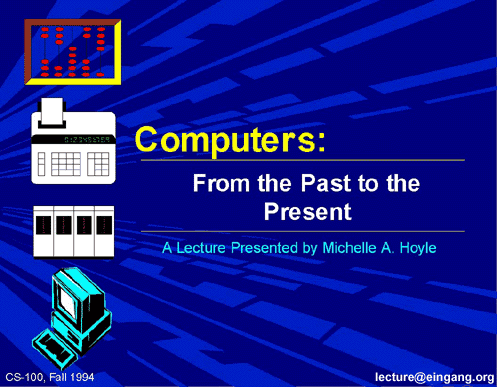 |
Introduction
Welcome to Calypso's Lecture Series for CS-100. The first (and only) lecture in the series is about the history of computing from the past to the present. This offers the student or casual browser an overview of the advances in science that made desktop computers possible starting with the invention of counting.This lecture was originally given in the fall of 1994 at the University of Regina (Regina, Canada) for 400 CS-100 students. CS-100 is an introductory course designed primarily for students from other disciplines. It was not intended for the computing science major student. As such, this material was geared to appeal to those students.The author would like to thank the copyright holders of the various pictures used in this work without formal acknowledgement. For copyright information, please contact the author Michelle A. Hoyle (thelectureATeingangNOSPAMorg)..Future additions to the lecture include a section discussing the impact of business microcomputers and mainframes to the history of computing.Teachers, this lecture is available to be used on a standalone machine in a classroom. Drop me some mail (thelectureATeingangNOSPAMorg) if you would like a copy for use in a classroom, museum, or kiosk. Replace the AT and NOSPAM with an @ and a . respectivelyNavigation
Contents:
- The Shamanistic Tradition
- Stonehenge: A Primitive Calendar
- The Abacus: A Primitive Calculator
- The Forefathers of Computing Science
- Pascal's Pascaline Calculator
- The Difference Engine
- The Conditional
- Herman Hollerith
- Binary Representation
- The Harvard Mark I

Computers: From the Past to the Present
Introduction: Last modified July 30, 2006
©1994-2006 by Michelle A. Hoyle
Introduction: Last modified July 30, 2006
©1994-2006 by Michelle A. Hoyle
No comments:
Post a Comment